The Importance of Material Handling Solutions in Modern Warehouses
Material handling is a critical function within any warehouse or distribution center. It encompasses the movement, storage, protection, and control of goods throughout the supply chain. However, generic, one-size-fits-all solutions often fall short of addressing the specific challenges faced by different industries.
Material handling solutions customized to the unique requirements of a facility can:
- Enhance operational efficiency by reducing unnecessary movement and handling of goods
- Improve space utilization through optimized storage systems
- Reduce labor costs by automating repetitive tasks
- Increase throughput to meet higher demand with fewer resources
By focusing on tailored solutions, warehouses can optimize their processes and achieve sustained growth.
Benefits of Custom Material Handling Solutions
1. Increased Efficiency through Process Optimization
Every warehouse has unique workflows based on its layout, inventory, and operational requirements. Custom material handling solutions analyze these workflows to identify bottlenecks and inefficiencies. By redesigning processes and integrating the right equipment, warehouses can achieve seamless material flow and reduced lead times.
Key Strategies:
- Designing efficient picking and packing stations
- Implementing optimized conveyor and sortation systems
- Integrating warehouse management systems (WMS) for real-time data tracking
2. Enhanced Flexibility and Scalability
Custom solutions offer the flexibility to adapt to changing operational demands. Whether a business is scaling up due to increased demand or diversifying its product range, tailored material handling systems can accommodate these changes without significant disruptions.
Examples of Flexible Solutions:
- Modular racking systems that can be reconfigured as needed
- Scalable automation technologies, such as Automated Guided Vehicles (AGVs), which can be added incrementally
3. Improved Accuracy and Reduced Errors
Manual handling processes are prone to errors, which can lead to delays, damaged goods, and dissatisfied customers. Custom solutions that incorporate automation and precision technologies can significantly reduce these errors.
Innovative handling technologies like robotic picking systems and barcode scanning ensure that products are handled accurately, reducing the risk of incorrect shipments and inventory discrepancies.
Custom Solutions for Specialized Industries
Different industries have distinct material handling needs. For example:
- E-commerce warehouses require high-speed picking and packing solutions to handle a large volume of small orders.
- Automotive facilities need systems capable of managing heavy and bulky components.
- Pharmaceutical warehouses must prioritize accuracy and compliance with strict regulatory standards.
Custom solutions designed for these specific environments ensure that each facility operates at peak efficiency while meeting industry-specific requirements.
The Role of Material Handling Automation
One of the most significant trends in custom material handling is the adoption of automation technologies. Material handling automation not only reduces the reliance on manual labor but also provides data-driven insights that help optimize operations.
Key Automation Technologies:
- Automated Storage and Retrieval Systems (AS/RS): These systems automate the storage and retrieval of goods, improving accuracy and reducing labor costs.
- AGVs (Automated Guided Vehicles): AGVs transport materials throughout the facility without human intervention, reducing labor requirements and improving efficiency.
- Robotic Picking Systems: These robots handle repetitive picking tasks with speed and precision, freeing up human workers for more complex tasks.
While automation requires an upfront investment, the long-term benefits, including reduced lead times and increased throughput, far outweigh the initial costs. Additionally, businesses looking to manage AGV cost can explore modular systems that allow gradual implementation.
Mobility Solutions: Enhancing Internal Logistics
Effective internal logistics are essential for improving warehouse operations. Custom mobility solutions, such as electric carts and motorized equipment, enhance the movement of goods within a facility, reducing the time required for material transfers.
Benefits of Mobility Solutions:
- Faster movement of materials across different warehouse zones
- Reduced manual handling and associated labor costs
- Enhanced safety and ergonomics for workers
The Role of Heavy-Duty Industrial Casters in Custom Solutions
An often-overlooked component in material handling is the use of heavy-duty industrial casters. These casters are essential for ensuring smooth and efficient movement of heavy loads, particularly in industries dealing with bulky or weighty products.
Advantages of Heavy-Duty Industrial Casters:
- Increased Mobility: They facilitate the easy movement of heavy equipment and materials, improving overall workflow.
- Reduced Physical Strain: By minimizing the effort required to move heavy loads, they contribute to a safer and more ergonomic work environment.
- Customizable Design: Available in various sizes and load capacities, heavy-duty casters can be tailored to the specific needs of a facility.
Integrating high-quality casters into custom material handling systems can significantly enhance operational efficiency and safety.
How to Improve Warehouse Operations with Custom Solutions
Improving warehouse operations requires a holistic approach that considers both the physical layout and the technologies used. Here are some steps to achieve this:
- Conduct a Comprehensive Audit: Assess current workflows, equipment, and space utilization to identify areas for improvement.
- Engage with Solution Providers: Collaborate with experts who can design and implement custom material handling systems tailored to your needs.
- Integrate Technology: Leverage automation, robotics, and data analytics to optimize processes and improve decision-making.
- Focus on Continuous Improvement: Regularly review and update your systems to adapt to changing operational demands and technological advancements.
Conclusion
Custom material handling solutions are a powerful tool for increasing productivity and maintaining a competitive edge in today’s dynamic marketplace. By focusing on tailored processes, flexible systems, and advanced automation, businesses can streamline their operations, reduce costs, and improve overall efficiency.
From automated storage systems to heavy-duty industrial casters, every component plays a crucial role in enhancing warehouse performance. By investing in custom solutions and continuously seeking ways to improve warehouse operations, companies can position themselves for long-term success in an ever-evolving industry.







